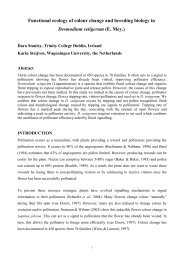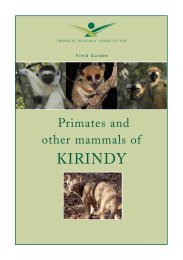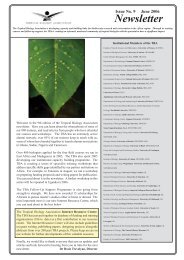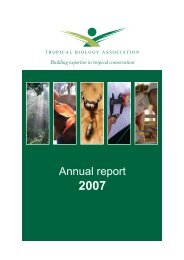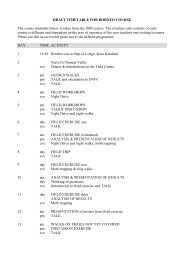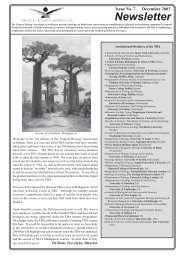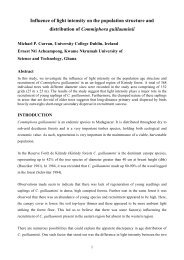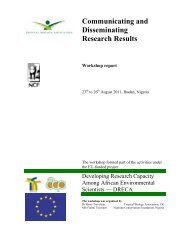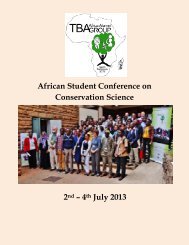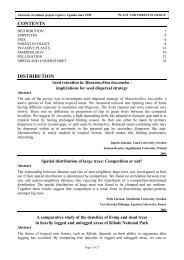Download TAAG Book of Abstracts - Tropical Biology Association
Download TAAG Book of Abstracts - Tropical Biology Association
Download TAAG Book of Abstracts - Tropical Biology Association
Create successful ePaper yourself
Turn your PDF publications into a flip-book with our unique Google optimized e-Paper software.
Coping Strategies by Chimpanzees (Pan troglodytes<br />
schweinfurthii) during Fruit Scarcity in Gishwati<br />
Montane Forest Fragment, Rwanda<br />
Rebecca L. Chancellor, Aaron S. Rundus, and Sylvain<br />
Nyandwi<br />
Forest <strong>of</strong> Hope <strong>Association</strong>, Gishwati Forest Reserve, PO<br />
Box 538 Rubavu, Rwanda<br />
Email for correspondence: sylnyapi@gmail.com<br />
Abstract<br />
The increased number <strong>of</strong> primates living in fragmented<br />
habitats necessitates greater knowledge <strong>of</strong> how they<br />
cope with large-scale changes to their environment.<br />
Chimpanzees are exceptionally vulnerable to forest<br />
fragmentation; however, little is known about<br />
chimpanzee feeding ecology in fragments. Although<br />
chimpanzees have been shown to prefer fruit when it is<br />
available and fall back foods during periods <strong>of</strong> fruit<br />
scarcity, the information is still needed for appropriate<br />
conservation strategy. We examined how chimpanzees<br />
cope with fruit scarcity in Gishwati, a disturbed montane<br />
forest fragment. We assessed seasonal changes in<br />
chimpanzee diet and the use <strong>of</strong> preferred and fallback<br />
foods through faecal and food site analysis. We also<br />
examined seasonal variation in nest group size and<br />
habitat use through marked nest censuses. We realized<br />
that chimpanzees experienced a seasonal reduction in<br />
preferred fruit availability, which led to a seasonal diet<br />
change. Our results suggest that during periods <strong>of</strong> fruit<br />
scarcity the chimpanzees reduced nest group size.<br />
However, we found that the chimpanzees did not alter<br />
their habitat use between high- and low-fruit seasons,<br />
which suggests that the forest smallness limits their<br />
ability to change their seasonal habitat use.<br />
Consequently, fallback foods appear to be particularly<br />
important in small food-impoverished habitats with<br />
limited ranging options.<br />
Keywords:Fallback foods, Forest fragments, Gishwati,<br />
Pan troglodytes, Rwanda<br />
Study on Density and Diversity <strong>of</strong> Leaf Litter Insects at<br />
Amani Nature Reserve, Tanzania<br />
EsraElfaki<br />
University <strong>of</strong> Khartoum faculty <strong>of</strong> Science department <strong>of</strong><br />
Zoology<br />
Email for correspondence: remma94@gmail.com<br />
Abstract<br />
Leaf litter provides food and shelter for earthworms,<br />
millipedes, spiders and other forest insects. Insects are<br />
essential components <strong>of</strong> the food web and ecosystem;<br />
and most importantly, leaf litter insects are one <strong>of</strong> the<br />
most important components <strong>of</strong> a forest ecosystem due<br />
to the role they play in processes such as<br />
decomposition, nutrient cycling and maintenance <strong>of</strong> soil<br />
fertility within a forest. The spatial variation in leaf litter<br />
composition is expected to affect both the density and<br />
diversity <strong>of</strong> leaf litter insects which is good indicator for<br />
environmental health and forest biotic integrity. This<br />
study therefore focused on the comparative analysis <strong>of</strong><br />
leaf-litter insects in three different habits which include<br />
Bamboo shrubs, Japanese camphor and Eucalyptus<br />
species located in Amani Nature Reserve, Tanzania. A<br />
total <strong>of</strong> 1919 insects from 8 different orders Blattodea,<br />
Coleoptera, Collembola, Diptera, Hemiptera,<br />
Hymenoptera, Orthoptera and Thysanura were<br />
collected from pitfall traps, and 658 species from<br />
quadrat plots. Diptera had higher numbers compared to<br />
other orders with 13 families. Results revealed no<br />
difference in diversity <strong>of</strong> leaf litter insects between<br />
habitats. Furthermore, the depth <strong>of</strong> litter had no<br />
influence on insects’ abundance between habitats. Most<br />
<strong>of</strong> the insects are also discovered to be active at night.<br />
The quadrat method gave better results in studies <strong>of</strong><br />
leaf litter insects. Amani Forest is rich in leaf litter insect<br />
diversity; this indicates forest stability and good for<br />
conservation <strong>of</strong> forest insects.<br />
Keywords: Insect diversity, Leaf litter, Amani Nature<br />
Reserve, insect abundance<br />
<strong>TAAG</strong> First African Student’s Conference, Nairobi. 2-4 July, 2013 49




